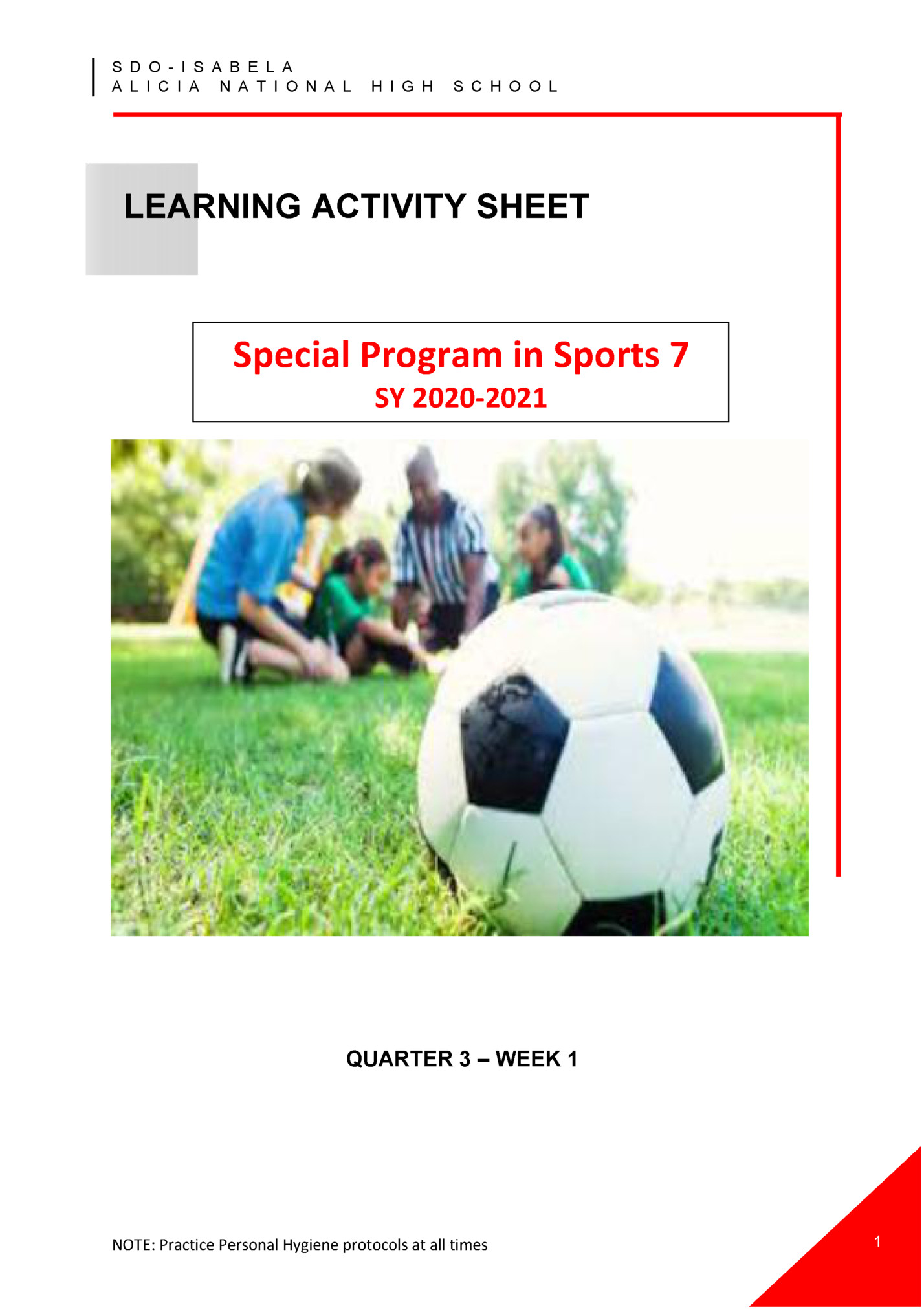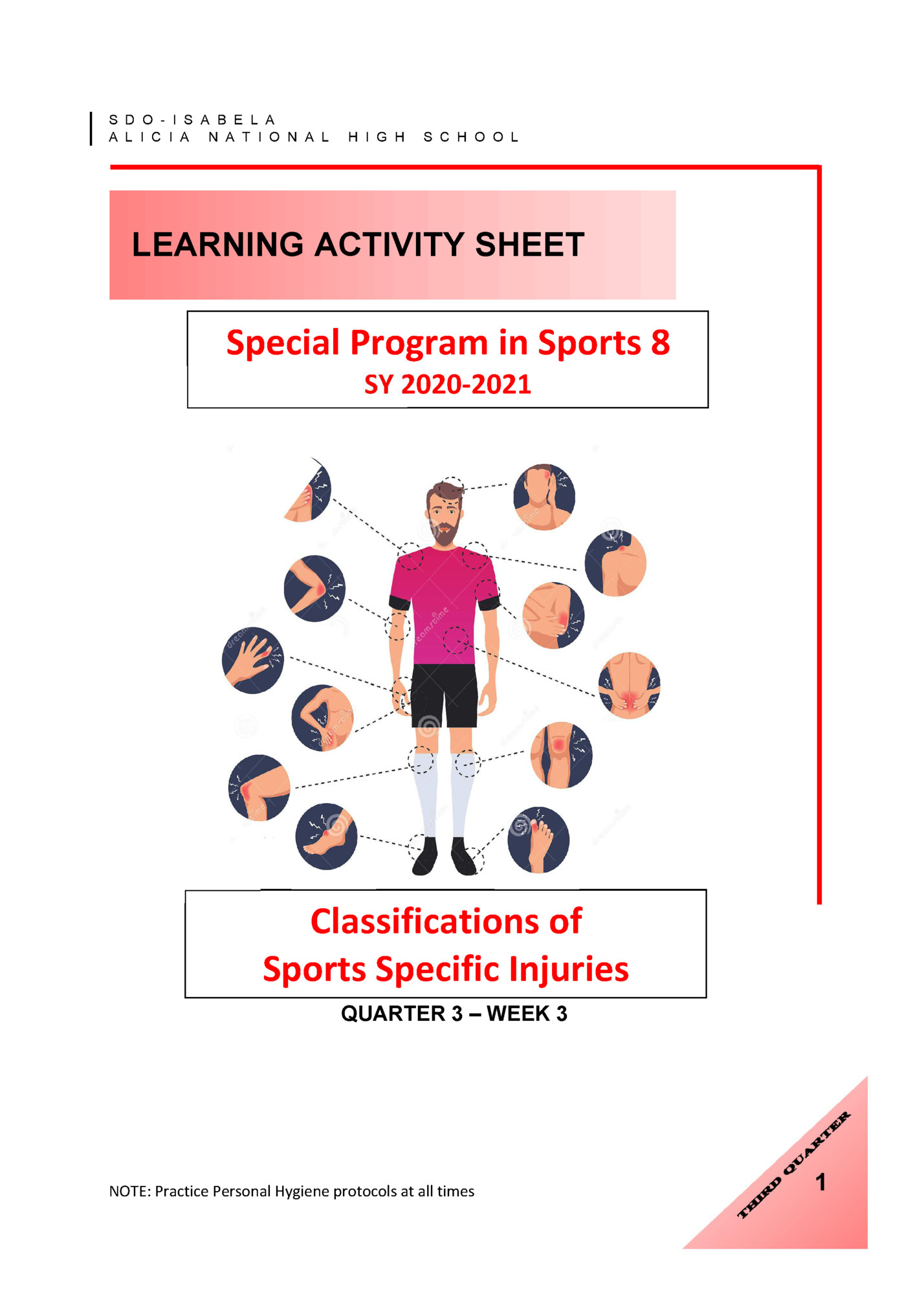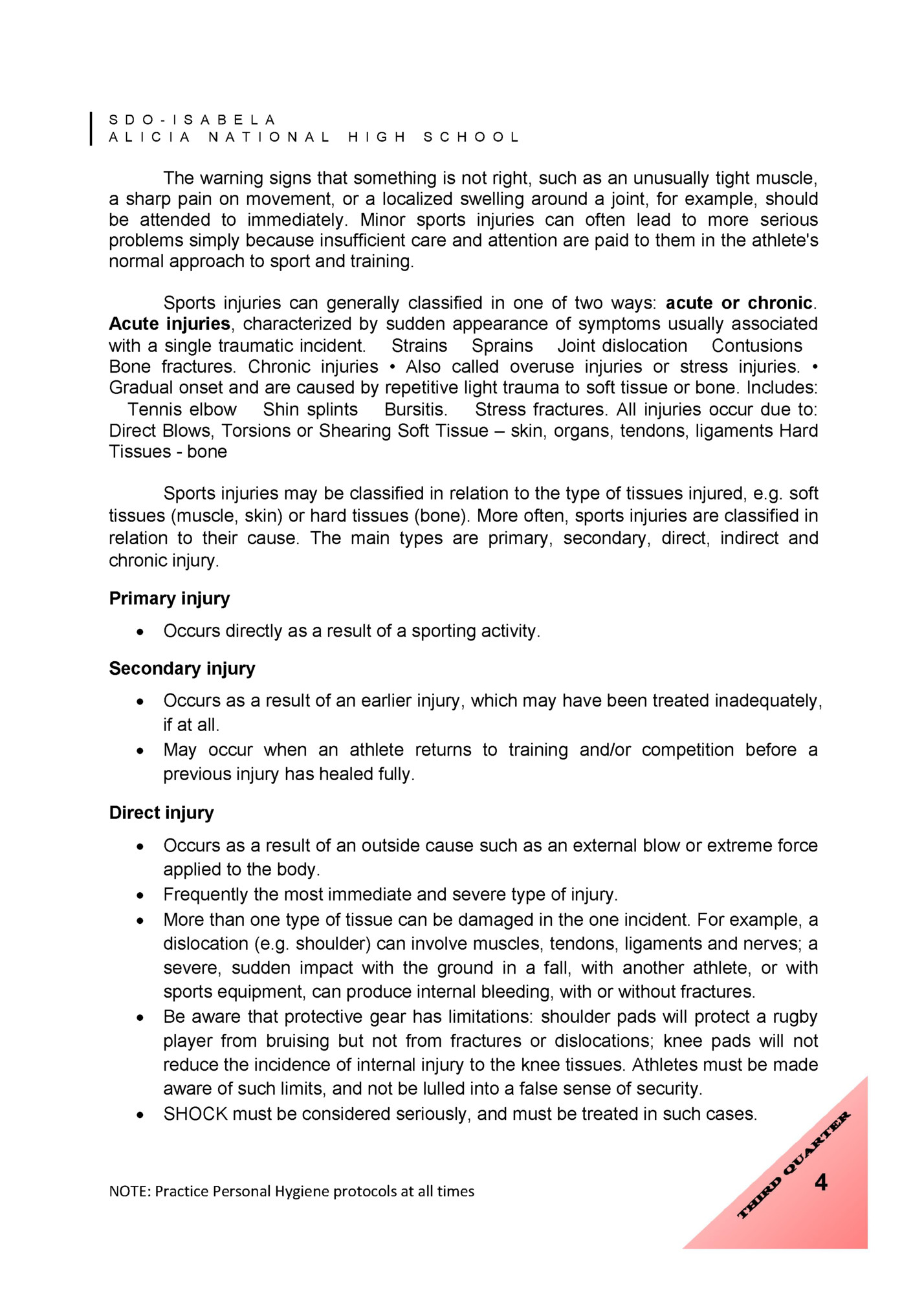A L I C I A N A T I O N A L H I G H S C H O O L LEARNING ACTIVITY SHEET Special Program in Sports 7 SY 2020-2021 QUARTER 3 – WEEK 1 NOTE: Practice Personal Hygiene protocols at all times 1

A L I C I A N A T I O N A L H I G H S C H O O L BACKGROUND INFORMATION FOR LEARNERS Hi Guys, in this lesson you will able to know and differentiate the two types of injuries in the world of sports. Exercising and sports are good for you, but they sometimes lead to injury. Some sports injuries result from accidents while others are due to poor training practices, improper equipment or lacking of conditioning. The term ‘sports injury’ refers to the kinds of injuries that may be sustained during sports or exercise. Sports injuries can be broadly categorized into 2 types – chronic and acute injuries. It is important to be able to distinguish these 2 kinds of injuries, as it would give you a better idea of how to manage them. Below, you can check out several information about chronic and acute injury. LEARNING COMPETENCY Explains the difference between acute and chronic injuries DIRECTIONS/INSTRUCTIONS HOW TO USE THIS MATERIAL? 1. Read well every part of the material. Use the suggested references or other related references as guide in answering the activities. 2. Follow correctly the instructions. Ask the help or assistance of your parents or siblings as much as possible. 3. There are learning activities in this material. Strictly follow, what is/are asked in every activity and accomplish the activity within the given timeline. 4. In case, the materials in the activity are not available in your place, you may improvise or use related materials. 5. If you have good internet connection, you may use the digital version of this material. Ask your subject teacher how. NOTE: Practice Personal Hygiene protocols at all times 2

A L I C I A N A T I O N A L H I G H S C H O O L LEARNING ACTIVITY 1: INJURIES CHRONIC and ACUTE WHAT SHALL YOU LEARN FROM THE ACTIVITY Define chronic and acute injuries; Differentiate chronic and acute injuries. READ Defining Chronic and Acute injuries CHRONIC INJURY A chronic injury is the result of prolonged, repetitive motion that is particularly common in endurance sports such as swimming, running and cycling. As such, chronic injuries are often referred to as overuse injuries – injuries resulting from overusing one body area while playing a sport or exercising over a long period. Common types of chronic sports injuries • • • • • • • • Stress fractures Tennis elbow Shin splints Runner's knee Heel inflammation Ankle sprain Groin pull Hamstring strain These injuries are commonly related to one of the following – improper technique, trying to progress too fast, or overdoing certain motions while playing a sport. They are commonly associated with sports such as long distance running, cycling and swimming. ACUTE INJURY An acute injury, on the other hand, is an injury that occurs suddenly and is usually associated with trauma such as cracking a bone, tearing a muscle or bruising. It could be a result of falling or crashing into another player during sports. Chronic/overuse sports injuries outnumber sudden acute injuries in almost every athletic activity, but because these injuries are not instantly disabling, they attract less medical attention than those that cause a sudden and obvious loss of function. NOTE: Practice Personal Hygiene protocols at all times 3

A L I C I A N A T I O N A L H I G H S C H O O L STOPOVER 1. How can we determine Acute injury? 2. Why is Runner's knee considered as the most common chronic injury among athletes? 3. As a student-athlete, why do you think it is important for you to know and understand the two types of sports injuries? 4. How do you know if an injury is acute or chronic? 5. When does an injury go from acute to chronic? ADDITIONAL TASK: Activity 1: Read and analyze each statement carefully and identify whether it falls under ACUTE INJURY or CHRONIC INJURY. Write your answer in the space provided before the number. Write AI (Acute Injury) and CI (Chronic Injury) ______Occurs when there is sudden stress on the body ______Overuse injuries occur due to repeated powerful muscle movements. ______Caused by training too hard, not allowing time for recovery, poor footwear and bad technique. ______Collisions with opponents or obstacles. ______Being struck by an object ______Falling from a height or at speed. ______Caused by continuous stress on a body part over a long time. ______Suddenly hit by an implement (ball,bat,arrow GUIDE QUESTIONS Guys, using a Venn diagram answer the following guide questions to check your learnings. What is CHRONIC injury? What is ACUTE injury? What are the similarities of Chronic and Acute injuries? NOTE: Practice Personal Hygiene protocols at all times 4

A L I C I A N A T I O N A L H I G H S C H O O L REFLECTION Congratulations our dear learner! You already grasped much learning about the Chronic and Acute Injuries. Write a concise essay explaining the extent to which you agree or disagree to the question below. You may write your answer in English or Filipino. As a student-athlete, why do you think it is important for you to know and understand the two types of sports injury? (Bilang isang estudyanteng-atleta, bakit napakahalagang malaman at maintindihan mo ang dalawang uri ng Sport Injury?) __________________________________________________________________________________ __________________________________________________________________________________ __________________________________________________________________________________ __________________________________________________________________________________ __________________________________________________________________________________ __________________________________________________________________________________ __________________________________________________________________________________ REFERENCES FOR LEARNERS https://www.adventhealth.com/hospital/adventhealth-orlando/blog/acute-and-chronic-sportsinjuries-whats-difference Acute and Chronic Sports Injuries – What’s the Difference? (2019, March 13) Retrieved September 21, 2020 ANSWER KEY Stop Over 1 Answer may vary Additional Task Acute Injury Chronic Injury Chronic Injury Acute Injury Acute Injury Acute Injury Chronic Injury Acute Injury Guide Question: Answer may vary Prepared by: Evaluated by: JAIME M. CAGUNGUN, JR. SPS Teacher/Writer ARISTON L. DE GUZMAN SPS Coordinator NOTE: Practice Personal Hygiene protocols at all times 5

A L I C I A N A T I O N A L H I G H S C H O O L LEARNING ACTIVITY SHEET Special Program in Sports 8 SY 2020-2021 Classifications of Sports Specific Injuries QUARTER 3 – WEEK 3 NOTE: Practice Personal Hygiene protocols at all times 1

A L I C I A N A T I O N A L H I G H S C H O O L BACKGROUND INFORMATION FOR LEARNERS This unit is designed to explore knowledge and skills that will help you and your family develop a lifelong habit of physical fitness and wellness. Athlete, fitness enthusiast or not, sports medicine can help you recover from a sports injury. Sports injuries are injuries or damages that occur to one or more parts of the body during sporting activities. These kinds of injuries can take place during any type of sport or situation and are very common. The extent of the injuries and the type of damage they cause depends on a variety of factors including the specific type of activity whether it’s exercising at the gym, running, .Football, Tennis, Basketball, Boxing, or Golf among others. For a professional athlete, a severe injury may force one to discontinue his or her career, while other sports injuries are less consequential and can easily be treated. The branch of medicine tasked with the management and treatment of sports injuries is referred to as Sports Medicine or Orthopedic medicine. The medical professional with the requisite training in handling cases of sports injuries is known as a sports doctor/orthopedic surgeon. Sports injuries can be defined as the physical alignment that hinder a person’s sports performance and prevent him/her from performing. Injuries can be trivial or more serious, and they can be classified in a variety of ways. Injuries can be described as Intrinsic or Extrinsic (described later). They can also be classified according to the type of tissue that is injured, for example, soft, hard and special tissue injuries. They can also be classified by the type of infliction being put upon the tissue - direct or indirect impact. LEARNING COMPETENCY Describes the classifications of Sports specific injuries. (Quarter 3- Week 3) NOTE: Practice Personal Hygiene protocols at all times 2

A L I C I A N A T I O N A L H I G H S C H O O L DIRECTIONS/INSTRUCTIONS HOW TO USE THIS MATERIAL? 1. Read well every part of the material. Use the suggested references or other related references as guide in answering the activities. 2. Follow correctly the instructions. Ask the help or assistance of your parents or siblings as much as possible. 3. There are three (3) learning activities in this materials. Strictly follow, what is/are asked in every activity and accomplish the activity within the given timeline. 4. In case, the materials in the activity are not available in your place, you may improvise or use related materials. 5. If you have good internet connection, you may use the digital version of this material. Ask your subject teacher how. LEARNING ACTIVITY 1: Sports Specific Injuries WHAT SHALL YOU LEARN FROM THE ACTIVITY o Discusses the classifications of sports specific injuries. REA D Physically active people, particularly athletes', are always going to have some vulnerability to injury. People can sustain new injuries; aggravate old ones, or be managing injuries on a day to day basis. Injuries are encountered in a number of ways' on the field, in training and competition, in the fitness studio, and during normal daily activities. Whether you are fitness obsessive or a reluctant exerciser - any individual can suffer an injury. The very best in preparation, from careful training and using correct equipment to the performance tactics during competitions; still cannot guarantee an injury free performer. However, if the athlete is fit enough for the activities they are involved in, and knows how to prepare, in terms of warm-up, apparel, and mental approach, the risks are minimized. NOTE: Practice Personal Hygiene protocols at all times 3

A L I C I A N A T I O N A L H I G H S C H O O L The warning signs that something is not right, such as an unusually tight muscle, a sharp pain on movement, or a localized swelling around a joint, for example, should be attended to immediately. Minor sports injuries can often lead to more serious problems simply because insufficient care and attention are paid to them in the athlete's normal approach to sport and training. Sports injuries can generally classified in one of two ways: acute or chronic. Acute injuries, characterized by sudden appearance of symptoms usually associated with a single traumatic incident. Strains Sprains Joint dislocation Contusions Bone fractures. Chronic injuries • Also called overuse injuries or stress injuries. • Gradual onset and are caused by repetitive light trauma to soft tissue or bone. Includes: Tennis elbow Shin splints Bursitis. Stress fractures. All injuries occur due to: Direct Blows, Torsions or Shearing Soft Tissue – skin, organs, tendons, ligaments Hard Tissues - bone Sports injuries may be classified in relation to the type of tissues injured, e.g. soft tissues (muscle, skin) or hard tissues (bone). More often, sports injuries are classified in relation to their cause. The main types are primary, secondary, direct, indirect and chronic injury. Primary injury Occurs directly as a result of a sporting activity. Secondary injury Occurs as a result of an earlier injury, which may have been treated inadequately, if at all. May occur when an athlete returns to training and/or competition before a previous injury has healed fully. Direct injury Occurs as a result of an outside cause such as an external blow or extreme force applied to the body. Frequently the most immediate and severe type of injury. More than one type of tissue can be damaged in the one incident. For example, a dislocation (e.g. shoulder) can involve muscles, tendons, ligaments and nerves; a severe, sudden impact with the ground in a fall, with another athlete, or with sports equipment, can produce internal bleeding, with or without fractures. Be aware that protective gear has limitations: shoulder pads will protect a rugby player from bruising but not from fractures or dislocations; knee pads will not reduce the incidence of internal injury to the knee tissues. Athletes must be made aware of such limits, and not be lulled into a false sense of security. SHOCK must be considered seriously, and must be treated in such cases. NOTE: Practice Personal Hygiene protocols at all times 4

Fleepit Digital © 2021